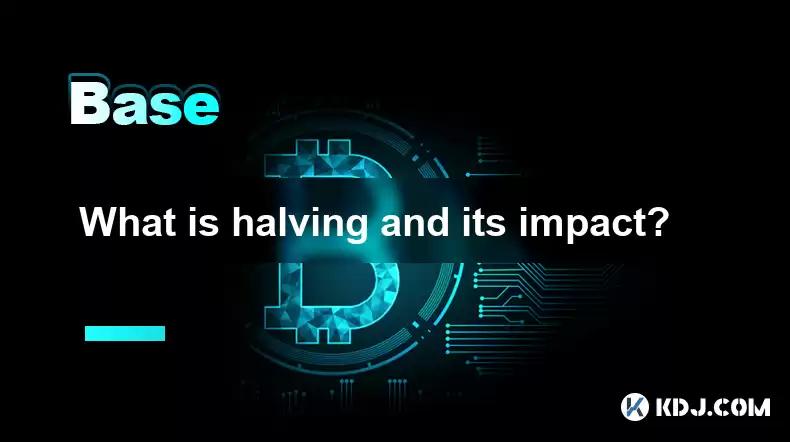-
 Bitcoin
Bitcoin $115100
1.27% -
 Ethereum
Ethereum $3675
2.71% -
 XRP
XRP $2.995
1.45% -
 Tether USDt
Tether USDt $1.000
0.02% -
 BNB
BNB $769.8
2.64% -
 Solana
Solana $168.0
3.25% -
 USDC
USDC $0.9999
-0.01% -
 TRON
TRON $0.3371
1.48% -
 Dogecoin
Dogecoin $0.2051
3.36% -
 Cardano
Cardano $0.7394
2.30% -
 Hyperliquid
Hyperliquid $38.15
0.42% -
 Stellar
Stellar $0.3966
-0.36% -
 Sui
Sui $3.486
2.93% -
 Chainlink
Chainlink $16.72
2.52% -
 Bitcoin Cash
Bitcoin Cash $568.0
4.36% -
 Hedera
Hedera $0.2440
2.59% -
 Ethena USDe
Ethena USDe $1.001
0.04% -
 Avalanche
Avalanche $22.16
2.06% -
 Litecoin
Litecoin $119.1
-0.73% -
 UNUS SED LEO
UNUS SED LEO $8.991
0.04% -
 Toncoin
Toncoin $3.232
-0.39% -
 Shiba Inu
Shiba Inu $0.00001233
2.82% -
 Uniswap
Uniswap $9.717
2.53% -
 Polkadot
Polkadot $3.664
1.85% -
 Dai
Dai $1.000
0.01% -
 Monero
Monero $281.2
-3.89% -
 Bitget Token
Bitget Token $4.350
1.55% -
 Cronos
Cronos $0.1428
5.07% -
 Pepe
Pepe $0.00001050
3.68% -
 Aave
Aave $262.3
3.54%
What is halving and its impact?
Bitcoin's halving, occurring every 4 years, reduces mining rewards, impacting miners' profitability and contributing to the cryptocurrency's deflationary nature.
Apr 07, 2025 at 05:28 pm

Halving is a significant event in the cryptocurrency world, particularly for Bitcoin and other cryptocurrencies that use a similar mechanism. Halving refers to the process by which the reward for mining new blocks is reduced by half. This event is programmed into the protocol of certain cryptocurrencies to control the rate at which new coins are generated and to mimic the scarcity of precious metals like gold.
The Mechanics of Halving
The concept of halving is straightforward but has profound implications. For Bitcoin, halving occurs approximately every four years, or every 210,000 blocks. When Bitcoin was first launched, the reward for mining a block was 50 BTC. After the first halving in 2012, this reward was reduced to 25 BTC. Subsequent halvings in 2016 and 2020 further reduced the reward to 12.5 BTC and 6.25 BTC, respectively. The next halving is expected to occur around 2024, reducing the reward to 3.125 BTC per block.
Impact on Miners
Halving directly affects miners, who are responsible for validating transactions and adding them to the blockchain. The reduction in block rewards means that miners receive fewer new bitcoins for their efforts. This can impact their profitability, especially if the price of Bitcoin does not increase sufficiently to offset the reduced rewards. Miners with higher operational costs may find it challenging to continue operating profitably, potentially leading to a decrease in the overall hash rate of the network.
Impact on Bitcoin's Supply
One of the primary purposes of halving is to control the supply of Bitcoin. By reducing the rate at which new bitcoins are created, halving helps to create a deflationary effect. Bitcoin has a maximum supply cap of 21 million coins, and halving ensures that this cap is approached gradually. This controlled supply can contribute to the perception of Bitcoin as a store of value, similar to gold.
Impact on Price
The impact of halving on Bitcoin's price is a topic of much debate and speculation. Historically, Bitcoin's price has experienced significant increases following halving events. This is often attributed to the reduced supply of new bitcoins entering the market, which, if demand remains constant or increases, can lead to higher prices. However, it's important to note that many factors influence Bitcoin's price, and halving is just one of them.
Market Sentiment and Speculation
Halving events often generate significant market sentiment and speculation. As the event approaches, traders and investors may anticipate price increases and adjust their strategies accordingly. This can lead to increased volatility in the market. Media coverage and discussions within the cryptocurrency community can further amplify these effects, creating a self-fulfilling prophecy where the anticipation of a price increase leads to actual price increases.
Long-Term Implications
The long-term implications of halving are closely tied to the overall adoption and acceptance of Bitcoin. As the reward for mining continues to decrease, the security of the network may depend more on transaction fees rather than block rewards. This shift could incentivize more users to use Bitcoin for transactions, thereby increasing its utility and value. Additionally, the continued reduction in new supply could reinforce Bitcoin's status as a digital asset with a finite supply, potentially attracting more institutional and long-term investors.
Halving in Other Cryptocurrencies
While Bitcoin is the most well-known cryptocurrency to implement halving, other cryptocurrencies have adopted similar mechanisms. For example, Litecoin, often referred to as the "silver to Bitcoin's gold," also undergoes halving events approximately every four years. The impact of halving on these cryptocurrencies can be similar to Bitcoin, with reduced block rewards affecting miners and potentially influencing price and market dynamics.
Technical Considerations for Miners
For miners, preparing for a halving event involves several technical considerations. Upgrading mining hardware to more efficient models can help offset the reduced rewards. Additionally, miners may need to adjust their operational strategies, such as optimizing energy consumption or seeking out cheaper electricity sources. Some miners may also choose to pool their resources with others to increase their chances of successfully mining blocks and sharing the rewards.
Frequently Asked Questions
Q: How does halving affect the overall security of the Bitcoin network?
A: Halving can impact the security of the Bitcoin network by affecting the profitability of mining. If the reduced block rewards lead to a significant number of miners leaving the network, the overall hash rate could decrease, potentially making the network more vulnerable to attacks. However, if the price of Bitcoin increases sufficiently to offset the reduced rewards, miners may continue to secure the network effectively.
Q: Can halving events be predicted with certainty?
A: Halving events can be predicted with a high degree of accuracy based on the number of blocks mined. Since the Bitcoin protocol is designed to produce a new block approximately every 10 minutes, the timing of halving events can be estimated. However, slight variations in block times can lead to small deviations in the actual date of the halving.
Q: Are there any cryptocurrencies that do not implement halving?
A: Yes, not all cryptocurrencies implement halving. For example, Ethereum, which uses a different consensus mechanism called Proof of Stake, does not have a halving mechanism. Instead, Ethereum's issuance of new coins is managed through a different set of rules that do not involve reducing block rewards over time.
Q: How do halving events affect the long-term viability of mining as a profession?
A: Halving events can make mining less profitable over time, especially if the price of the cryptocurrency does not increase sufficiently. This can lead to a consolidation of mining operations, where only the most efficient and well-capitalized miners remain profitable. As a result, mining as a profession may become more challenging for smaller operators, potentially affecting the decentralized nature of the network.
Disclaimer:info@kdj.com
The information provided is not trading advice. kdj.com does not assume any responsibility for any investments made based on the information provided in this article. Cryptocurrencies are highly volatile and it is highly recommended that you invest with caution after thorough research!
If you believe that the content used on this website infringes your copyright, please contact us immediately (info@kdj.com) and we will delete it promptly.
- Avalanche vs. Ruvi AI: Daily Sales Tell a Story of Crypto Disruption
- 2025-08-07 06:29:35
- DeSoc: The Crypto to Buy Now for a Decentralized Future (and Maybe 43x Gains!)
- 2025-08-07 06:50:16
- Arctic Pablo Coin: Riding the Meme Coin Wave with a Deflationary Twist
- 2025-08-07 07:18:13
- XRP Price Skyrocket? Decoding the Cryptocurrency's Next Move
- 2025-08-07 07:31:50
- Meme Coins in August 2025: Riding the Rally Wave
- 2025-08-07 06:56:08
- Big Whales, Altcoins, and Heavy Transactions: What's Moving the Crypto Market?
- 2025-08-07 06:29:35
Related knowledge

What is the difference between CeFi and DeFi?
Jul 22,2025 at 12:28am
Understanding CeFi and DeFiIn the world of cryptocurrency, CeFi (Centralized Finance) and DeFi (Decentralized Finance) represent two distinct financia...

How to qualify for potential crypto airdrops?
Jul 23,2025 at 06:49am
Understanding What Crypto Airdrops AreCrypto airdrops refer to the distribution of free tokens or coins to a large number of wallet addresses, often u...

What is a crypto "airdrop farmer"?
Jul 24,2025 at 10:22pm
Understanding the Role of a Crypto 'Airdrop Farmer'A crypto 'airdrop farmer' refers to an individual who actively participates in cryptocurrency airdr...

What is the difference between a sidechain and a Layer 2?
Jul 20,2025 at 11:35pm
Understanding the Concept of SidechainsA sidechain is a separate blockchain that runs parallel to the main blockchain, typically the mainnet of a cryp...

What is the Inter-Blockchain Communication Protocol (IBC)?
Jul 19,2025 at 10:43am
Understanding the Inter-Blockchain Communication Protocol (IBC)The Inter-Blockchain Communication Protocol (IBC) is a cross-chain communication protoc...

How does sharding improve scalability?
Jul 20,2025 at 01:21am
Understanding Sharding in BlockchainSharding is a database partitioning technique that is increasingly being adopted in blockchain technology to enhan...

What is the difference between CeFi and DeFi?
Jul 22,2025 at 12:28am
Understanding CeFi and DeFiIn the world of cryptocurrency, CeFi (Centralized Finance) and DeFi (Decentralized Finance) represent two distinct financia...

How to qualify for potential crypto airdrops?
Jul 23,2025 at 06:49am
Understanding What Crypto Airdrops AreCrypto airdrops refer to the distribution of free tokens or coins to a large number of wallet addresses, often u...

What is a crypto "airdrop farmer"?
Jul 24,2025 at 10:22pm
Understanding the Role of a Crypto 'Airdrop Farmer'A crypto 'airdrop farmer' refers to an individual who actively participates in cryptocurrency airdr...

What is the difference between a sidechain and a Layer 2?
Jul 20,2025 at 11:35pm
Understanding the Concept of SidechainsA sidechain is a separate blockchain that runs parallel to the main blockchain, typically the mainnet of a cryp...

What is the Inter-Blockchain Communication Protocol (IBC)?
Jul 19,2025 at 10:43am
Understanding the Inter-Blockchain Communication Protocol (IBC)The Inter-Blockchain Communication Protocol (IBC) is a cross-chain communication protoc...

How does sharding improve scalability?
Jul 20,2025 at 01:21am
Understanding Sharding in BlockchainSharding is a database partitioning technique that is increasingly being adopted in blockchain technology to enhan...
See all articles

























































































